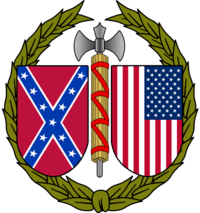Seven Days' Battles

| |
| Seven Days' Battles | |
|---|---|
| Begun | June 26, 1862 |
| Ended | July 3, 1862 |
| Army of the Potomac | |
| Commander | MGEN George B. McClellan |
| Army of Northern Virginia | |
| Commander | GEN Robert E. Lee |
The Seven Days' Battles were a series of battles fought outside Richmond, Virginia, between June 25 and July 1, 1862, during the American Civil War. They happened when Confederate General Robert E. Lee decided to attack the Army of the Potomac under General George B. McClellan, who had slowly advanced the Army of the Potomac to whithin miles of Richmond, the Confederate capital. Lee, recently given command of the Army of Northern Virginia, understood McClellan to be cautious in battle and believed that a series of attacks could lead him to withdraw from his campaign. Tactically, the battles were relatively indecisive; although the Confederates did cause the Federals to withdraw, it was at an extreme cost the Army of Northern Virginia could not bear for long. McClellan, however, continued his cautious behavior and withdrew to Harrison's Landing on the James River. Unsatisfied with McClellan's actions during the battles, President Lincoln ordered McLellan to withdraw from the peninsula and move north to support General John Pope's Army of Virginia. The individual battles were:
Oak Grove (June 25): minor skirmish that preceded Confederate assaults.
Beaver Dam Creek (June 26): Beginning of the main Confederate assault was only moderately successful due to uncharacteristic sluggishness by General Thomas Jackson and over-aggressiveness by General A.P. Hill; however, convinced he was outnumbered (a perpetual problem), General McClellan withdrew.
Gaine's Mill (June 27): In the largest Confederate attack of the war, the Army of Northern Army continued to push the Army of the Potomac back. General John Magruder's command, south of the Chickahominy River, continued to convince McClellan of the existence of a larger Confederate force. McClellan spent much of his army south of the river waiting for this perceived threat, leaving the northern half of his army undermanned. Jackson continues to show his sluggishness, most likely a symptom of fatigue.
During the night, McClellan ordered the army to retreat to Harrison's Landing, despite holding a strong defensive position and dealing heavy casualties to the Confederate army.
Garnett's and Golding's Farm (June 27-28): Small attacks by Confederates that were easily repulsed but continued to convince McClellan he was outnumbered.
Savage's Station (June 29): General Magruder encountered the Federal rearguard, attempting to withdraw through White Oak Swamp. General Jackson could have easily supported the attack by crossing the Chickahominy at a ford, but instead chose to rest his men and rebuild bridges burnt during the Federal retreat.
Glendale (June 30): Attempting to withdraw through the swamp, the Union army became bottlenecked; however, the Confederate assault was, like many during the Seven Days', uncoordinated. Jackson again failed to play a major part in the battle, moving slowly, and the major assaults, under Generals James Longstreet and A.P. Hill, lacked cohesiveness.
Malvern Hill (July 1): The Union Army held, and stayed at, a strong defensive position for the first time of the battle. Rather than attempting to manuever, Lee again assaulted the Union head-on, suffering sever casualties. Lee retreated to Richmond and McClellan succesfully completed his retreat to the James River.
Assessment
Although the Army of Northern Virginia suffered excessive casualties due to uncoordinated leadership, poor tactial decisions by Lee and many of his generals, and a strange sluggishness not normally seen in Stonewall Jackson, the battle was a huge morale victory. McClellan had approached to within miles of Richmond, and many Northerners believed the war would be won. McClellan's withdrawal and the heavy losses caused a lack of confidence in McClellan. Although not fired from his post in command of the Army of the Potomac, General Henry Halleck was appointed above McClellan as General-in-Chief. Conversely, Lee became a hero where previously he had been noted for his failures in earlier Confederate campaigns. He also learned his lesson from the leadership failures of the battle and reorganized his army. For the following campaigns, Lee retained the aggressiveness that characterized the Seven Days' Battle.
The total casualties of the battles were:
| Army | total casualties |
|---|---|
| Confederacy | 20,733 |
| Union | 15,849 |
References
- ↑ Civil War: Battles and Leaders, edited by Aaron R. Murray, DK Publishing Inc., 2004, pp. 36-37.
National Park Service Historical Handbook